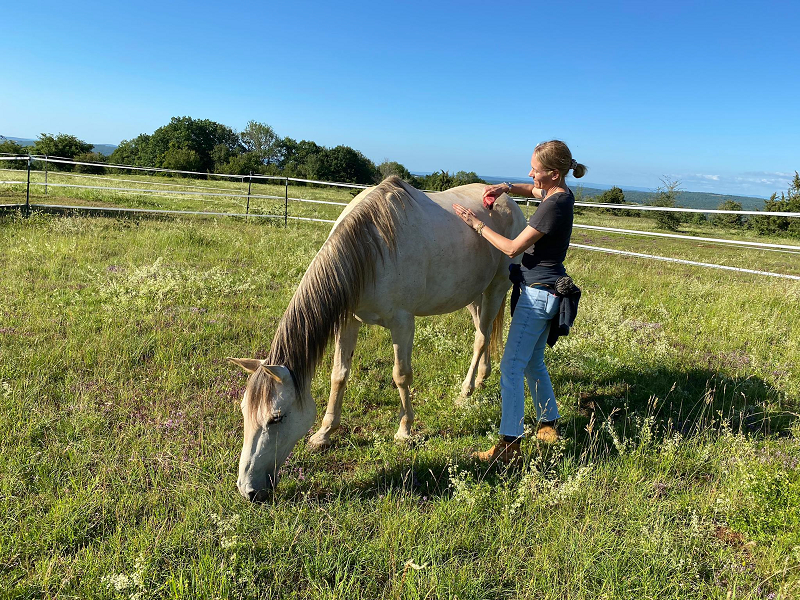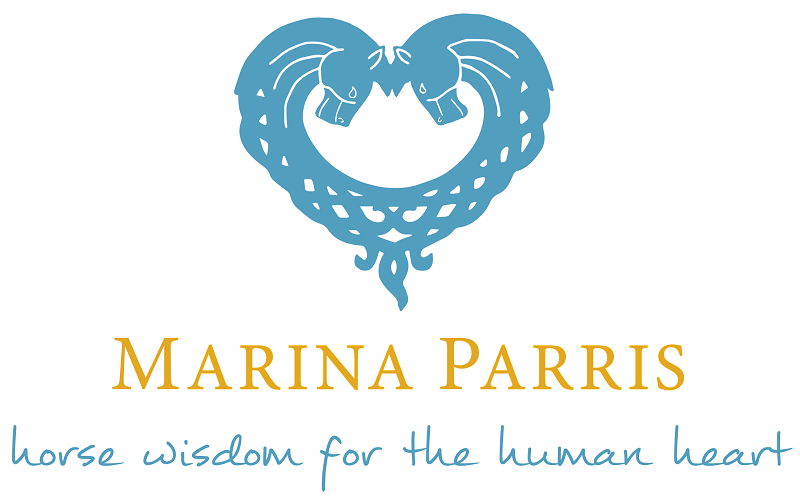
NEU: Flohmarkt & Fundgrube
Neu gibt es auf passion.4my.horse die Möglichkeit, Rest- und Einzelstücke für Pferd, Stall und Hof zu entdecken, zu kaufen oder auch zu verkaufen. Check it out!

A Heart for Horses will inspire and guide horse lovers on the journey of creating a true partnership with their horse. The book is for horse lovers open to learning from their horses and willing to reflect on and change their behavior and ways of thinking along the way.
A Heart for Horses will inspire and guide horse lovers on the journey of creating a true partnership with their horse. The book is for horse lovers open to learning from their horses and willing to reflect on and change their behavior and ways of thinking along the way. Working with horses in a way that they become true partners requires skills long-forgotten in today’s fast-paced world. This journey is transformational for both people and horses and will result in a beautiful and rewarding partnership that nourishes both heart and soul.
Die deutsche Übersetzung des nachfolgenden Textes findest Du hier.
So how can you tell when your horse accepts or approves of what you are doing? Acceptance takes place in the horse’s mind and is reflected in its body. Its body will be relaxed and its eyes soft. Your horse will move smoothly and feel good to you. It’s like having a good dance partner.
The difference between acceptance and tolerance is quite easy to see when horses are being groomed or have to stand still and wait a few minutes. I have seen so many horses that just tolerate grooming, because if they resist they get in trouble with the rider. If a horse is talking to you and you don’t listen, it makes it hard for a horse to truly accept you. Maybe it’s just trying to tell you that a certain brush or the way you are grooming doesn’t feel good.
We can also see the difference between acceptance and tolerance when teaching a horse to stand still and wait. Stopping usually isn’t the problem, but waiting is. Just because a horse is standing still physically doesn’t mean it means it’s standing still mentally, in its head. You can easily see this in its body language; the horse is tense, its head is up and it’s looking around. In this state, the horse is more or less tolerating the situation. If the head is high and the horse is looking around, it’s usually just waiting for you not to pay attention for a moment so it can walk off and move its feet.
It may take a few repetitions of teaching the horse to wait until you say it’s okay to walk off. If a horse who is still in the learning process is nervous, you need to wait for the one second when it focuses on you and then walk off together with the horse. Always keep in mind what behavior you desire. If you’d like the horse to check in with you to see if it’s okay to walk off, then you want to reward this behavior. Should it walk off without checking in, don’t give in just because it’s easier to do so. Stop the horse and wait for it to relax and focus on you, and then walk off together.
When horses are tense while being groomed, led or ridden, or simply when they are in the presence of people, often they are just tolerating the interaction with the human. It’s the same as when you may just be tolerating your boss at work; you’d rather work for someone else, but you simply have to deal with the situation until you can change things. It’s the same for horses. There will always be situations that both horses and people have to put up with, but these should be the exceptions and not the rule.
The most common sign of tolerance is when a horse swishes its tail. The horse is saying, “Okay, I’ll do it, but something about your asking is not okay with me.” Maybe your timing was off, or you were unbalanced or unclear. It’s important to note that when a horse is merely tolerating a person, it’s difficult for it to focus on much else because of the inner resistance toward what it’s being asked to do. You want to have a horse in an open frame of mind, willing to listen to what you’re asking it to do.
Just as important as your horse accepting you as a friend, leader and rider, you want to make sure it also accepts the saddle (its placement, type of cinch), the bit (how it’s worn and used as a form of communication) and any aids you use, such as a crop. It must never be afraid of any aid. I’ve seen horses move away as soon as someone lifted a crop—not a good sign. This often indicates the horse associates the crop with an unpleasant experience. Ideally, the crop is merely seen an extension of your arm by your horse. This means you can stroke the horse all over its body with the crop as you could with your hand.
To move from tolerance to acceptance, you need to be aware of how and what you are doing and present things in a way that is suitable to the horse. Like a great dancer, everything must be done with feel and be fine-tuned based on the horse’s reaction. When something feels good to your horse, it will enjoy the time with you; otherwise, it will prefer to be back at the stable with the other horses.
“If you get ahead of him, it is just tolerance and not acceptance. If push comes to shove, he will take over instead of filling in for you.”
—Ronnie Willis
A Heart for Horses wird Pferdeliebhaber auf dem Weg zu einer echten Partnerschaft mit ihrem Pferd inspirieren und begleiten. Das Buch richtet sich an Pferdeliebhaber, die bereit sind, von ihren Pferden zu lernen und auf diesem Weg ihr Verhalten und ihre Denkweise zu überdenken und zu ändern. Mit Pferden so zu arbeiten, dass sie zu echten Partnern werden, erfordert Fähigkeiten, die in der heutigen schnelllebigen Welt längst vergessen sind. Diese Reise ist sowohl für den Menschen als auch für das Pferd von grosser Bedeutung und wird zu einer schönen und lohnenden Partnerschaft führen, die Herz und Seele nährt.
Woran kannst du also erkennen, dass dein Pferd akzeptiert oder gutheisst, was du tust? Akzeptanz findet im Kopf des Pferdes statt und spiegelt sich in seinem Körper wider. Dein Körper ist entspannt und seine Augen sind weich. Dein Pferd bewegt sich geschmeidig und fühlt sich gut an. Es ist, als hätte es einen guten Tanzpartner.
Der Unterschied zwischen Akzeptanz und Toleranz ist leicht zu erkennen, wenn Pferde gestriegelt werden oder ein paar Minuten stillstehen und warten müssen. Ich habe so viele Pferde gesehen, die das Striegeln nur tolerieren, denn wenn sie sich wehren, bekommen sie Ärger mit dem Reiter. Wenn ein Pferd mit dir redet und du nicht zuhörst, ist es für das Pferd schwer, dich wirklich zu akzeptieren. Vielleicht versucht es nur, dir mitzuteilen, dass ihm eine bestimmte Bürste oder die Art und Weise, wie du es striegelst, nicht gefällt.
Der Unterschied zwischen Akzeptanz und Toleranz wird auch deutlich, wenn man einem Pferd beibringt, stillzustehen und zu warten. Das Anhalten ist normalerweise nicht das Problem, sondern das Warten. Nur weil ein Pferd körperlich stillsteht, heisst das noch lange nicht, dass es auch geistig stillsteht, in seinem Kopf. Man kann das leicht an der Körpersprache erkennen: Das Pferd ist angespannt, hat den Kopf hocherhoben und schaut sich um. In diesem Zustand toleriert das Pferd die Situation mehr oder weniger. Wenn der Kopf hocherhoben ist und das Pferd sich umschaut, wartet es normalerweise nur darauf, dass du einen Moment lang nicht aufpasst, damit es loslaufen und seine Füsse bewegen kann.
Es kann einige Wiederholungen brauchen, um dem Pferd beizubringen, dass es warten soll, bis du ihm sagst, dass es gehen darf. Wenn ein Pferd, das sich noch im Lernprozess befindet, nervös ist, musst du die eine Sekunde abwarten, in der es sich auf dich konzentriert, und dann zusammen mit dem Pferd weggehen. Behalte dir immer im Hinterkopf, welches Verhalten du dir wünschst. Wenn du möchtest, dass sich das Pferd bei dir meldet, um zu sehen, ob es losgehen darf, dann solltest du dieses Verhalten belohnen. Wenn es weggeht, ohne sich zu melden, solltest du nicht nachgeben, nur weil es einfacher ist, dies zu tun. Halte das Pferd an und warte, bis es sich entspannt und auf dich konzentriert, und geht dann gemeinsam weg.
Wenn Pferde beim Striegeln, Führen oder Reiten oder einfach in der Gegenwart von Menschen angespannt sind, tolerieren sie oft nur die Interaktion mit dem Menschen. Es ist dasselbe, wie wenn du dein Chef bei der Arbeit nur tolerierst; du würdest lieber für jemand anderen arbeiten, aber du musst einfach mit der Situation umgehen, bis du etwas ändern kannst. So ist es auch bei Pferden. Es wird immer Situationen geben, die sowohl Pferde als auch Menschen erdulden müssen, aber das sollten die Ausnahmen sein und nicht die Regel.
Das häufigste Zeichen für Toleranz ist, wenn ein Pferd mit dem Schweif wedelt. Das Pferd will damit sagen: “Okay, ich mache es, aber irgendetwas daran, dass du es verlangst, ist für mich nicht in Ordnung. Vielleicht war dein Timing falsch, oder du warst unausgeglichen oder unklar. Es ist wichtig zu wissen, dass es für ein Pferd, das eine Person lediglich toleriert, schwierig ist, sich auf etwas anderes zu konzentrieren, weil es sich innerlich gegen das wehrt, was von ihm verlangt wird. Du möchtest doch ein Pferd haben, das offen ist und bereit ist, auf das zu hören, was du von ihm verlangst.
Genauso wichtig wie die Tatsache, dass dein Pferd dich als Freund, Führer und Reiter akzeptiert, ist es, dass es auch den Sattel (seine Platzierung, die Art des Gurtes), das Gebiss (wie es getragen und als Kommunikationsmittel eingesetzt wird) und alle von dir verwendeten Hilfen, wie z. B. eine Gerte, akzeptiert. Es darf niemals Angst vor einem Hilfsmittel haben. Ich habe schon Pferde gesehen, die weggingen, sobald jemand eine Gerte anhob – kein gutes Zeichen. Das deutet oft darauf hin, dass das Pferd die Gerte mit einer unangenehmen Erfahrung assoziiert. Im Idealfall wird die Gerte von deinem Pferd lediglich als Verlängerung deines Arms gesehen. Das bedeutet, dass du das Pferd mit der Gerte am ganzen Körper streicheln kannst, wie du es auch mit der Hand kannst.
Um von der Toleranz zur Akzeptanz zu gelangen, müssen du dir bewusst sein, wie und was du tust, und die Dinge so präsentieren, dass sie für das Pferd geeignet sind. Wie bei einem guten Tänzer muss alles mit Gefühl gemacht und auf die Reaktion des Pferdes abgestimmt werden. Wenn sich etwas für dein Pferd gut anfühlt, wird es die Zeit mit dir geniessen; andernfalls wird es lieber zurück in den Stall zu den anderen Pferden gehen.
“Wenn man ihm zuvorkommt, ist das nur Toleranz und keine Akzeptanz. Wenn es hart auf hart kommt, wird es die Führung übernehmen, anstatt für dich einzuspringen.”
—Ronnie Willis

Neu gibt es auf passion.4my.horse die Möglichkeit, Rest- und Einzelstücke für Pferd, Stall und Hof zu entdecken, zu kaufen oder auch zu verkaufen. Check it out!
4my.horse bietet das einfachste Tool der Welt, um Kurse zu publizieren und Anmeldungen zu verwalten! Das Tool ist integrierter Bestandteil des Pferdekursportals 4my.horse.
Gute Pferdeausbildung muss man erleben, riechen, begreifen und vor allem sehen, fühlen und verstehen.
Am vergangenen Wochenende organisierte Werner Ulrich seine 25. Drivers Challenge im Nationalen Pferdezentrum..
Am 19. April erscheint die Frühlings-Ausgabe des Schweizer Reitmagazins PASSION. Als offizieller Medienpartner berichtet PASSION selbstverständlich ausführlich.
0 Kommentare